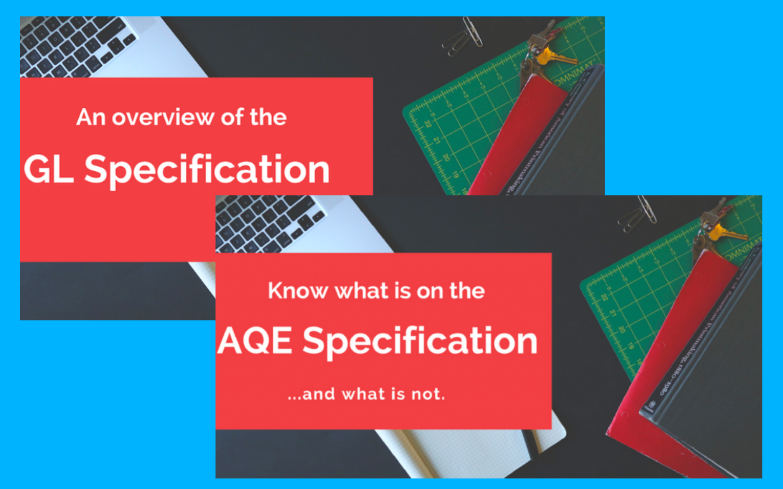Don’t Panic

For some people, the whole notion of AQE and GL can be quite daunting and if you’re a first-timer this is understandable, but don’t worry, I’m here to help and it’s quite straightforward.
However, if you are anxious the biggest piece of advice I can give you is not to panic. There is plenty of time to make a great start and with a little organisation, you’ll have the whole process mastered in no time at all.
Read The Exam Specification

At the start of any test preparation, the specification is always the first place to start. You need to read the specification for each of the exams which your child is planning to sit (AQE, GL or both) and carefully analyse what will be tested and what will not be tested.
I suggest printing it off and reading it through with the child and at each item, asking them if they are happy with that topic. You may be surprised how enlightening this quick and simple exercise can be and how reassuring it can also be for both you and the child.
In addition, over the coming months, use the specification as your reference guide and if you ever come across a question which makes you wonder if it would actually be tested on the real day, have a look at the specification and check what is written there and what is expected.
To help you with this, you can find the AQE Specification and the GL Specification details by clicking on their links.
Buy Yourself A Notebook

This is a great idea for tackling the white paper tests and making sure there is real learning taking place, so I hope this helps.
1. Buy yourself a notebook (Poundland have a good range) and when your child does a practice paper at home or at school, sit down with the child and go through it to identify either, silly mistakes or true knowledge gaps.
Let’s say the child got 50% in a test (don’t panic, all is fine), just sit down and go through the paper and ask the child how they got each one wrong:
- Did they just misread the question? For example, it asked for change of £5 rather than the total cost of goods, if so, this would be a SILLY mistake because the child does know how to add and subtract.
- Did they just not know how to do it? Super – these are the gold nuggets and the ones we’re interested in! For example, if a child is asked which two lines are parallel and the child tells you they didn’t know what parallel meant. They may know after the test but there’s a chance it’s only in their short term memory, so these are the questions you’ll want to capture.
2. Put the date at the top of the page and write down all the questions that they didn’t know (not silly mistakes) into the notebook. Don’t write the answers.
3. Count the percentage of the silly mistakes and let’s say they added to 20%, you can let the child know that they actually knew 70% of that paper which is fabulous (rather than them feeling they only got 50%)!
And just keep going and every couple of months (leave it a good time so they may have forgotten), have a look back with the child on the questions they’ve previously got wrong and test them again.
This will offer a number of benefits:
✅ It will let you (and the child) see real progress and increase their confidence.
✅ It will encourage the child to be more careful and drive out the silly mistakes.
✅ It will also highlight common silly mistakes e.g. child reading a 0 as a 6 and allow you to deal with these.
✅ It will identify real knowledge gaps / weaker areas that may need a little extra work outside a test.
✅ It will give more value and learning from a single test paper that is often discarded and binned when used once.
Also, in the run up to the actual tests, you could look at all the questions and change the figures and detail,to test real understanding e.g. when working out the mph, instead of John driving 30miles in 30mins, you could make it Simon driving 45miles in 45mins.
Join The Free Facebook Support Group

The Facebook Support Group is an amazing place where as a member, you’ll not miss a single beat of anything that is happening in AQE / GL land.
There are over 8,000 members with a lot of experience on tap, it’s a great place to get an insight (by simply listening) or direct advice (by asking) on anything to do with AQE or GL – from the transfer process or even asking for support on a particular question which you may be struggling with at home (these are my personal favourite type of posts).
Manage Silly Mistakes

This section will give you a rough idea of the process to remove silly mistakes, but check out the full blog post dedicated to Removing Silly Mistakes as it gives you all the details on how to manage these mistakes with the ultimate aim of removing them completely.
Don’t just think they will magically disappear and the sooner you get started with a systematic approach, the greater your chances of success.
The blog focuses on a 5-Stage Process and has a great track record in supporting continuous improvement throughout the transfer cycle.
The Five Stages are:
- Identify The Silly Mistake
- Classify Into Categories
- Figure Out Root Cause
- Eliminate Silly Mistakes
- Taking Countermeasures
Consider The Transfer Tutor App

The Transfer Tutor App offers real value to the children who use it and I’m always receiving very positive messages from parents saying that it really takes the edge off the pressure of revision and genuinely makes learning fun as the child does it on their device.
At this stage in the process, an important point about the web-app is that the questions are broken down into topics and so, even if the full syllabus has not yet been finished in school, the child can still work on areas where they are familiar and focus on honing their knowledge in those areas.
In addition, a major difference between the web-app and white-paper tests, is that the child (and often the parent) will learn from the questions and it is not just another testing tool. Learning takes place in two ways:
- Hint Button. If a child gets stuck on a question, they can press the hint button which will give them help on the right approach. For example, if a child gets a question to calculate the area of an irregular shape, the hint button will say something like, ‘break the shape into two’ – just enough to get the child back on track without giving them the answer.
- Answers Explained At The End. We’ve all been there, marking a question and according to the answer sheet, the child got it wrong, but for the life of you, you can’t figure out why. Well the same thing happens for the child when they get a white-paper test back, but with the web-app, the answer is immediately marked as right or wrong and the logic is explained. This gives the child the eureka moments that enhances real learning. Those times when they shout,”Oh Yeah!”
What Others Say:

With over 600 Five-Star Google Reviews and Facebook ReviewsI’d say it’s probably worth checking out. I’m here to help and if you have any questions, you can use the contact form to ask me anything or send me a message via the Facebook Page.
How To Buy:

Simply choose the licence you need depending on the length of time you need access, click on the blue box, pay and then you’ll be off within minutes.
However, if there are younger siblings, you can choose a longer licence, for only another £15 per additional years! So, if this is something you would like to explore, click here to get more details and to look at the other membership options.
For any further questions, please contact me or check out the Frequently Asked Questions page.
Try It Out:

To give you a feel for the quizzes, why not try out the quick fire free quiz by clicking on the button below (no need to register or pay, so don’t worry). This will hopefully let you see how the questions work – or more importantly, let you see if this is something that would inspire and encourage your child to learn.
Social Media Links – Keeping Up To Date

Follow or like The Transfer Tutor on your social media channel of choice and ensure you never miss a beat with the whole transfer process, handy tips, advice, special offers and competitions.
Click below for your preferred channel or search for @TransferTutorHQ wherever you are.

